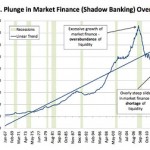This number may predict the stock market bubble – MarketWatch

SAN FRANCISCO (MarketWatch) — As the bull market in stocks and bonds shows no sign of slowing, investors are trying to time the inevitable: when it all comes crashing down.
It isn’t just MarketWatch. The financial media these days are filled with a mixed message: Growth is finally here and it’s time to invest — until it all ends like the orchestral crash at the end of The Beatles’ “A Day in the Life.”
The only question is when.
Try to make an investment with that hanging over your life savings.
It’s in this current climate that the Center for Financial Stability (CFS) late last month issued a report on financial-market liquidity. Without a financial or economics background, the report can be a little difficult to wade through, but basically it measures money market funds, repurchase agreements and commercial paper — the instruments that give the private sector the credit, or capacity, to expand. Think of it as the private market’s way of printing money.
CFS found that short-term credit, created and traded outside of the banking system, expanded slightly between January and February. That’s notable, as Michael Casey of The Wall Street Journal explained, because it’s the first time it’s happened since the collapse of Bear Stearns Cos. in March 2008 and may be a positive because “demand for these kinds of credit instruments could help boost the economy via the commercial paper market.”
The danger comes once the credit provided by shadow banks nears or crosses the long-term trend line.
An active credit market would take pressure off the Fed to provide cheap money. The free market would be working again, as it was designed.
Short-term credit used to be the main purview of banks, but they’ve scaled back their participation due to the changing environment and new regulations being enacted as part of the 2010 Dodd-Frank Act. If you’re familiar with the term “shadow banking,” that’s where this new money is being created.
So the fact that this part of the credit system is slowly growing can be taken as a positive. It shows investment by borrowers (mostly companies), and confidence of lenders (banks, funds and other institutions).
That means the recent increase in these credit products is a healthy sign that financial markets are moving back in balance. Private investors and underwriters are coming back to relieve the Fed.
Center for Financial Stability
In the short term, this is obviously a good thing. But there’s a limit. If you view the accompanying chart (above), you can see that this market began to explode during the bubble years leading up to the financial crisis and the Great Recession. In 2000, it veered higher than the trend line (much like housing prices). By 2008, it was a $7.5 trillion market, overbuilt by 50%, according to historical standards.
Today, the shadow banking credit market is at $4.124 trillion. That’s still more than 40% below the trend line. Indeed, it’s so far below the line, CFS President Lawrence Goodman wrote the report himself. “The world is plagued by a shortage of financial market liquidity despite an overabundance of central bank liquidity,” he wrote.
So the market not only has enough time and capacity to safely add to this number, it has to add to it. The danger comes once the credit provided by shadow banks nears or crosses the long-term trend line. It won’t happen for years at the current rate, but the lending will accelerate once interest rates rise and private financing becomes the more affordable option for borrowers.
What are the big flows driving the euro’s decline?
(3:28)
Once shadow-banking credit crosses the line, investors should know the end is likely nigh. They should also remember that these are not institutions that are regulated like banks. So they could collapse in a matter of months, weeks or days. Also, they’re tied to banks through counter-party arrangements that run both ways.
Ultimately, keeping an eye on the amount of credit non-bank institutions take on is a good gauge for investors. If there’s one lesson from the financial crisis, it’s that when Wall Street begins ramping up risk, you should probably reduce yours.
Source:
This number may predict the stock market bubble – MarketWatch

